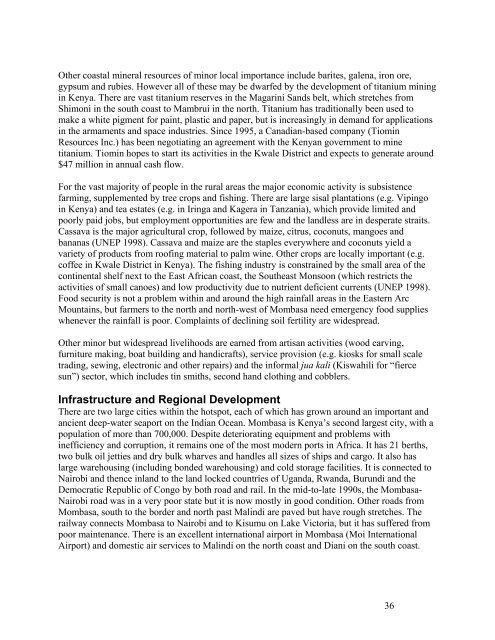Eastern Arc Mountains and Coastal Forests of Tanzania and Kenya ...
Eastern Arc Mountains and Coastal Forests of Tanzania and Kenya ...
Eastern Arc Mountains and Coastal Forests of Tanzania and Kenya ...
You also want an ePaper? Increase the reach of your titles
YUMPU automatically turns print PDFs into web optimized ePapers that Google loves.
Other coastal mineral resources <strong>of</strong> minor local importance include barites, galena, iron ore,gypsum <strong>and</strong> rubies. However all <strong>of</strong> these may be dwarfed by the development <strong>of</strong> titanium miningin <strong>Kenya</strong>. There are vast titanium reserves in the Magarini S<strong>and</strong>s belt, which stretches fromShimoni in the south coast to Mambrui in the north. Titanium has traditionally been used tomake a white pigment for paint, plastic <strong>and</strong> paper, but is increasingly in dem<strong>and</strong> for applicationsin the armaments <strong>and</strong> space industries. Since 1995, a Canadian-based company (TiominResources Inc.) has been negotiating an agreement with the <strong>Kenya</strong>n government to minetitanium. Tiomin hopes to start its activities in the Kwale District <strong>and</strong> expects to generate around$47 million in annual cash flow.For the vast majority <strong>of</strong> people in the rural areas the major economic activity is subsistencefarming, supplemented by tree crops <strong>and</strong> fishing. There are large sisal plantations (e.g. Vipingoin <strong>Kenya</strong>) <strong>and</strong> tea estates (e.g. in Iringa <strong>and</strong> Kagera in <strong>Tanzania</strong>), which provide limited <strong>and</strong>poorly paid jobs, but employment opportunities are few <strong>and</strong> the l<strong>and</strong>less are in desperate straits.Cassava is the major agricultural crop, followed by maize, citrus, coconuts, mangoes <strong>and</strong>bananas (UNEP 1998). Cassava <strong>and</strong> maize are the staples everywhere <strong>and</strong> coconuts yield avariety <strong>of</strong> products from ro<strong>of</strong>ing material to palm wine. Other crops are locally important (e.g.c<strong>of</strong>fee in Kwale District in <strong>Kenya</strong>). The fishing industry is constrained by the small area <strong>of</strong> thecontinental shelf next to the East African coast, the Southeast Monsoon (which restricts theactivities <strong>of</strong> small canoes) <strong>and</strong> low productivity due to nutrient deficient currents (UNEP 1998).Food security is not a problem within <strong>and</strong> around the high rainfall areas in the <strong>Eastern</strong> <strong>Arc</strong><strong>Mountains</strong>, but farmers to the north <strong>and</strong> north-west <strong>of</strong> Mombasa need emergency food supplieswhenever the rainfall is poor. Complaints <strong>of</strong> declining soil fertility are widespread.Other minor but widespread livelihoods are earned from artisan activities (wood carving,furniture making, boat building <strong>and</strong> h<strong>and</strong>icrafts), service provision (e.g. kiosks for small scaletrading, sewing, electronic <strong>and</strong> other repairs) <strong>and</strong> the informal jua kali (Kiswahili for “fiercesun”) sector, which includes tin smiths, second h<strong>and</strong> clothing <strong>and</strong> cobblers.Infrastructure <strong>and</strong> Regional DevelopmentThere are two large cities within the hotspot, each <strong>of</strong> which has grown around an important <strong>and</strong>ancient deep-water seaport on the Indian Ocean. Mombasa is <strong>Kenya</strong>’s second largest city, with apopulation <strong>of</strong> more than 700,000. Despite deteriorating equipment <strong>and</strong> problems withinefficiency <strong>and</strong> corruption, it remains one <strong>of</strong> the most modern ports in Africa. It has 21 berths,two bulk oil jetties <strong>and</strong> dry bulk wharves <strong>and</strong> h<strong>and</strong>les all sizes <strong>of</strong> ships <strong>and</strong> cargo. It also haslarge warehousing (including bonded warehousing) <strong>and</strong> cold storage facilities. It is connected toNairobi <strong>and</strong> thence inl<strong>and</strong> to the l<strong>and</strong> locked countries <strong>of</strong> Ug<strong>and</strong>a, Rw<strong>and</strong>a, Burundi <strong>and</strong> theDemocratic Republic <strong>of</strong> Congo by both road <strong>and</strong> rail. In the mid-to-late 1990s, the Mombasa-Nairobi road was in a very poor state but it is now mostly in good condition. Other roads fromMombasa, south to the border <strong>and</strong> north past Malindi are paved but have rough stretches. Therailway connects Mombasa to Nairobi <strong>and</strong> to Kisumu on Lake Victoria, but it has suffered frompoor maintenance. There is an excellent international airport in Mombasa (Moi InternationalAirport) <strong>and</strong> domestic air services to Malindi on the north coast <strong>and</strong> Diani on the south coast.36
















